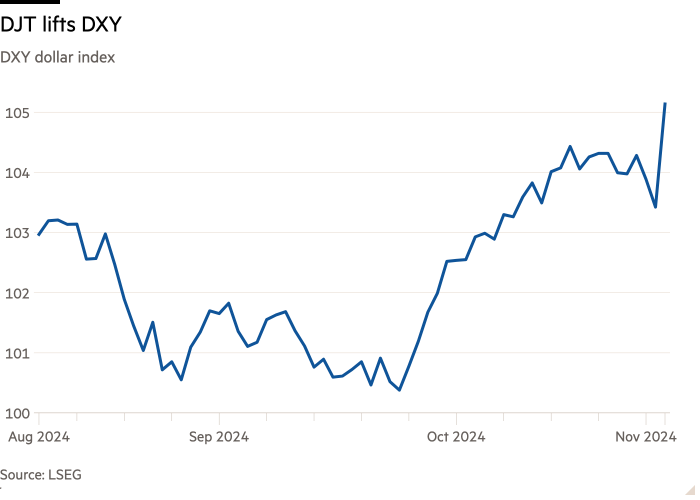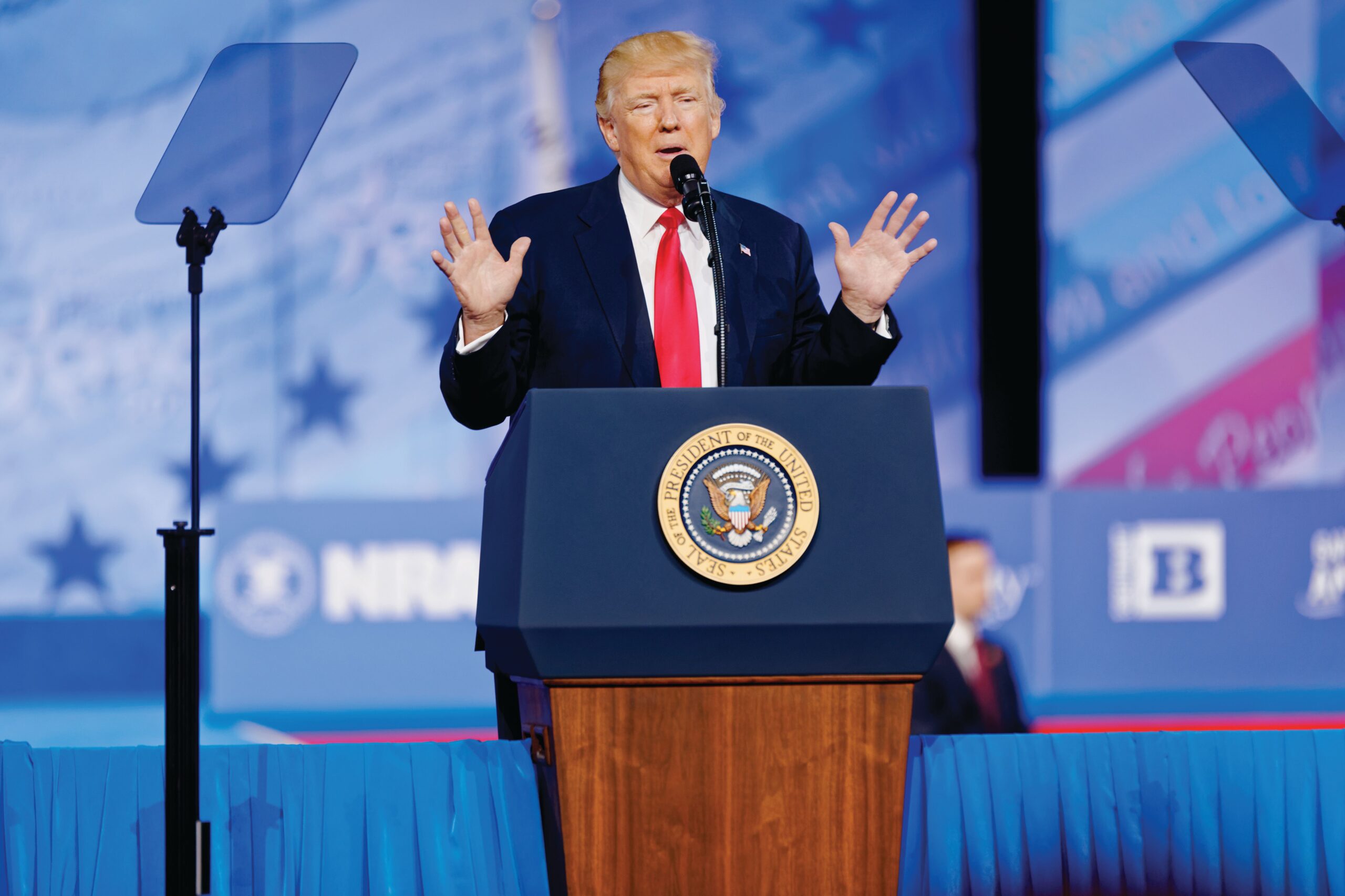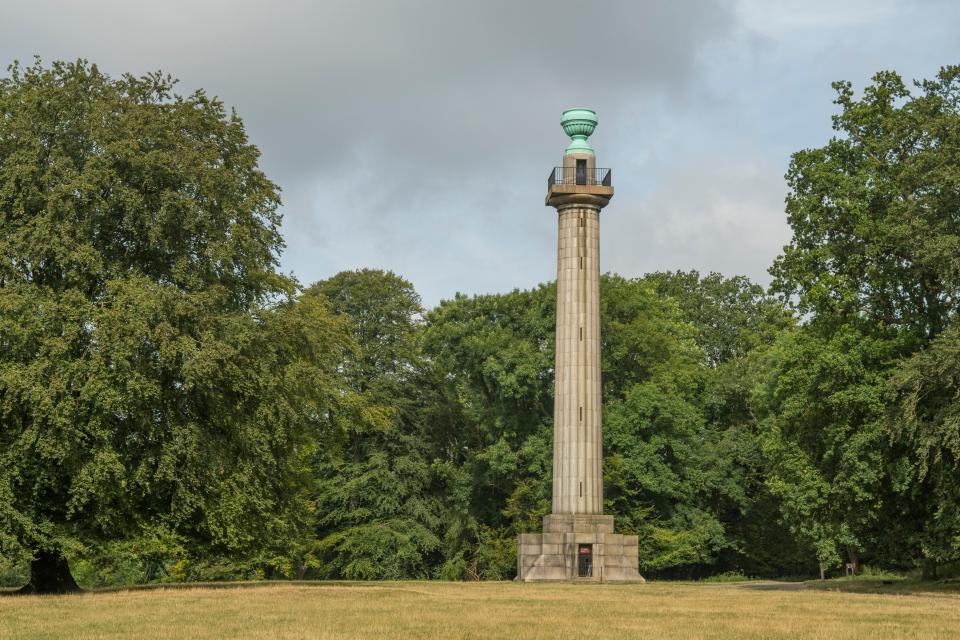Well, that’s that. Donald Trump will once again be president of the US — and this time fuelled with a desire for “retribution”, a greater popular mandate and at the head of a party now moulded in his image.
That means investors have to contemplate the possibility of a far more radical second term, with many more outlandish policies suddenly becoming at the very least possible. Greenland just got put back into play.
The main “Trump trade” has been to buy the dollar, on the view that Trump’s economic policies will be highly inflationary. This will force the Federal Reserve to shelve its plans for interest rate cuts and buoy the greenback. Higher tariffs dampen overseas purchases and also lift exchange rates, all things being equal.
As Kit Juckes of Société Générale said this morning:
President Trump would like a weaker dollar, but he isn’t going to get his way if he wants to run accommodative fiscal policy at a time when real GDP growth has averaged almost 3% for the last 5 years (and despite how things looked a few months ago, isn’t showing much sign of slowing at all). Throw in trade tariffs at a time when the unemployment rate is only at 4.1%, and he won’t get a weaker dollar, any more than Ronald Reagan was able to, in the first half of the 1980s.

However, this has always felt a little like a myopic, short-term trade, given Trump’s long-standing view that the dollar’s strength is hurting America. Along with the supposed magic of tariffs it is the closest he has to a firm, constant economic conviction.
As he told Bloomberg this summer:
So we have a big currency problem because the depth of the currency now in terms of strong dollar/weak yen, weak yuan, is massive. And I used to fight them, you know, they wanted it weak all the time. . . . . That’s a tremendous burden on our companies that try and sell tractors and other things to other places outside of this country. It’s a tremendous burden . . . I think you’re going to see some very bad things happen in a little while. I’ve been talking to manufacturers, they say we cannot get, nobody wants to buy our product because it’s too expensive.
Sure, Scott Bessent — a possible pick for a Republican administration Treasury Secretary — has insisted that Trump wants the dollar to keep its reserve status. Indeed, Trump has vowed 100 per cent tariffs on countries that shun the dollar in international trade.
But Republican vice-president candidate JD Vance seems to have Trump’s ear, and he has repeatedly argued that the negatives of the US currency’s reserve status outweigh the positives. Here he is questioning Fed chair Jay Powell last year:
This isn’t a policy he has flip-flopped on either. As Vance told Politico earlier this year: “‘Devaluing’ of course is a scary word, but what it really means is American exports become cheaper.”
Investors have generally discounted this rhetoric, on the view that presidents can jawbone currencies as much as they like but markets will do what markets will do. However, Trump now looks set to have won re-election with popular mandate and a Republican majority in at least the Senate, opening the possibility for more forceful action.
So here is FTAV’s guide on how the US can devalue the dollar if he really really wanted to.
Severe fiscal retrenchment (no, really!)
Reining in America’s yawning budget deficit would probably be the most orthodox of the radical options available to the Trump administration. It would weigh on economic growth, dampen inflation, send interest rates downward and thus weigh on the dollar.
As Barclays’ FX analysts Lefteris Farmakis and Themistoklis Fiotakis wrote in a September report on how Trump might engineer a dollar debasement:
Prima facie fiscal retrenchment is not about the dollar. If anything, it is the ‘responsible’ economic policy that the Fed, IMF and most international organisations deem necessary for the US following eight years of extraordinarily loose fiscal policy and mounting government debt.
However, fiscal tightening has direct implications for the dollar via slower economic growth, lower interest rates, and less favourable capital flows. Accordingly, it deserves to be included in the list of weak dollar policy options.
And various Trump hangers-on — like Vivek Ramaswamy and Elon Musk — have advocated for swingeing cuts to the size of the US government. The scale of what they’ve advocated would probably produce a swift recession.
However, nothing about Trump’s business career, his first term or his latest presidential election campaign indicate that he is suddenly about to become a paragon of fiscal rectitude.
When the Committee for a Responsible Federal Budget scored the policy proposals of Kamala Harris and Trump, it found that the latter would probably increase US government debt by $7.75tn by 2035 — twice what Harris’s budget would do.

So if we want realistic crazytown options, this is probably not it.
Tariffs and taxes and subsidies, oh my
Another more obvious way to affect the dollar’s value is to address America’s current account balance by fiddling around with levies on imports, subsidies for exports or even taxing overseas investments.
Tariffs have naturally received most of the attention, given Trump’s frequently-stated love for them (although he still doesn’t seem to grasp who actually pays them)
Here’s what Chris Marsh and Jens Nordvig of Exante Data wrote earlier this week on possible outcomes and scenarios:
Goods balance: imports. Lowering imports through tariffs intended to reduce demand for foreign traded goods while improving the competitiveness of domestic producers who may be able to fill the demand. Crucially, such a tariff is like a tax on US consumers, contributing to government revenues while reducing real incomes — this lowers domestic demand while increasing saving, thus current account adjustment. Foreign economies may try to lower their nominal exchange rate against USD to raise domestic currency incomes of exporters to offset some loss of export volumes, so having second or third round effects globally.
Goods balance: exports. Alternatively, boosting exports through subsidies to domestic producers to lower the price to foreigners of US output. This will contribute to higher fiscal deficit in the US which may be offset by higher private saving. So the impact on the current account is ambiguous. Alternatively, de-regulation of closed sectors (such as in energy) opens up competitive US markets to foreign consumers with less fiscal impact — raising domestic incomes and saving.
Service balance: Though net services run a surplus, efforts to improve net tourism or financial services through tax incentives is possible.
Primary income balance: a tax on foreign investment income (Treasury coupons) would generate fiscal revenue and contribute to a lowering external balance assuming no retaliation on US investment income abroad.
Such analysis is inevitably partial equilibrium as, to work out the ultimate impact on the current account and therefore currency of such actions, it is necessary to work through the final impact on incomes and expenditures of US residents as well as foreigners. For example, a tariff on imports will initially lower US real incomes. But this could trigger wage claims to offset lost income, require tighter monetary policy as a result, driving a stronger dollar alongside restored real incomes.
Tl;dr the impact isn’t as clear-cut as you might think, given the first, second and third derivatives of the various measures. Of course, that might not be enough to deter a Trump administration keener on action than analysis.
Occupy the Fed
Trump has never been a big fan of the Federal Reserve, frequently railing against its interest rate increases in his first term and making it clear that he’d replace Jay Powell when his term as chair ends in 2026. And if Trump really wants to debase the dollar, then occupying the Fed is an obvious way to do so.
The low-key way would simply be to gradually pack the Federal Reserve’s board with vaguely-credible (so they can get confirmed) but ultra-dovish members that will toe Trump’s low-interest-rate line.
Although controversial, this isn’t actually enormously different from what several presidents have done in the past. The point would be to ensure that interest rates stay lower than they really should, and that even a moderate erosion of the Fed’s independence and credibility would might spook international investors and dampen demand for US assets.
However, Trump could go far beyond what any of his predecessors have done. Given the US Supreme Court’s leanings, it might also be possible for Trump to actively eject sitting governors before their term ends, quickly stamping his mark on the institution.
As JPMorgan’s Michael Feroli has observed:
. . . There is some uncertainty as to whether the president can remove a Fed governor from their position as chair or vice chair. However, most legal scholars believe that even the current Supreme Court — which is often seen as favorably inclined toward executive authority — would respect the “for cause” limitation on the president’s authority to remove a sitting governor.
The administration and its potentates on the Fed board could then supercharge any damage inflicted on the dollar by halting the central bank’s balance sheet shrinkage and restarting a quantitative easing programme to contain the inevitable hit on long-term bonds.
As Farmakis and Fiotakis at Barclays wrote:
A scenario in which the Fed ends up accommodating yet more fiscal expansion in the absence of a negative output gap — per Trump’s proposed policies — could end up stoking inflation (and putting the stability of expectations at risk). This, in turn, would likely weigh on the dollar, but also keep borrowing costs elevated for much longer, in classic fiscal dominance fashion. What is more, any attempt by the Fed to contain long-term yields via a fresh round of QE would probably only serve to weaken the dollar even more severely.
Of course, all this isn’t costless either. Aggressive monetary easing would probably stir up inflation a bit, and even Trump can’t be blind to the fact that inflation is a major reason why he will soon be back in the White House.
But the Fed is almost certainly in for a bumpy ride, and the idea that Trump will be afraid of more radical action seems . . . optimistic.
A Mar-a-Lago Accord
The favoured approach by the dwindling number of American multilateralists would be something like the Plaza Accord of 1985, when the US browbeat its major trading partners into helping engineer a dollar devaluation.
This worked wonders at the time, with the DXY dollar index nearly halving from its 1985 peak by the end of the decade.

Naturally, analysts have dubbed a potential sequel “Mar-a-Lago Accord”, after Trump’s Florida abode. Marsh and Nordvig think this is the most viable solution:
The set-up is similar to today in that there is a wide fiscal deficit (so low US saving) with the potential for trading partners to acknowledge the need for nominal exchange rate adjustment under pressure of tariffs.
Such coordinated policy includes a fiscal consolidation by the US (raising domestic saving) associated with a managed appreciation of the currencies of trading partners. Today, this could include measures by China to improve transfers to households and support domestic demand.
Unlike the above, this approach has the benefit of being general equilibrium and simultaneously working on spending and income decisions in the US and trading partners, intended to switch spending patterns while sustaining overall demand.
The problem of course is that this is not the 1980s, when almost every country was suffering from a long and persistent bout of inflation that the strength of the dollar was clearly exacerbating.
And as you can see from the chart above, the dollar’s strength versus its main international peers was far more extreme and out of sync with the economic fundamentals in the 1980s than it is today. Most analysts today reckon the dollar is pretty fairly valued, given the strength of the US economy.
Moreover, a crucial component of the Plaza Accord was the US agreeing to get its fiscal house in order — which Trump is unlikely to do. Nor are China, Europe, Japan or other countries likely to be receptive to an engineered dollar devaluation, given how crucial trade is to their economies. They might be more willing to swallow the tariffs, Barclays notes:
In the 1980s, manufacturing accounted for as large a share of the US economy as in Germany and Japan today, while in China, it is as large today as Japan’s and Germany’s in the 1980s. Absent the inflationary cost and given domestic deleveraging policies in Europe and China, the bar is arguably higher for them to agree to coordinated dollar depreciation. Indicatively, trade has been a key source of growth in the eurozone in the past two years
Direct, aggressive and unilateral FX intervention
Now we’re cooking with gas.
The US actually has something called the Exchange Stabilization Fund, controlled by the US Treasury Secretary, who has “considerable discretion” in the use of its $211bn of assets to intervene in exchange rates.
The problem is that the ESF is puny compared to the size of the FX markets. Japan alone has $1.3tn of foreign currency reserves. The ESF could issue government bonds and use the extra firepower to buy foreign currencies, but this debt would naturally fall on the sovereign balance sheet, and thus face the old Congressional debt ceiling issue.
However, if the Trump administration enjoys de facto control over the House and installs a bevy of supine Federal Reserve governors, you could see many possible levers that they might push and pull. After all, engineering a currency devaluation is a lot easier than an appreciation — it just requires you to issue enough currency. A Fed brought to heel could do so.
This is obviously not without many complications — practical, political, legal and technical — but for Trump the optical benefit might also be to build a “sovereign wealth fund” in the process.
The Swiss National Bank’s assets ballooned from SFr85bn at the end 2007 to over SFr1tn by the end of 2021 — invested in everything from gold and German bonds to US equities — as it fought the Swiss franc’s appreciation.
Could this happen? These days, what can’t happen? ¯_ (ツ)_/¯









































































































































































You must be logged in to post a comment Login